Biostratigraphy and Microfacies of Upper Cretaceous Oceanic Red Beds in the Northern Tethyan Himalaya: A Case Study from the Zhangguo Section, Gyangze, Southern Tibet, China
Abstract
1. Introduction
2. Materials and Methods
3. Results
3.1. Planktic Foraminiferal Biostratigraphy
3.1.1. Dicariella asymetrica Zone
3.1.2. Globotruncanita elevata Zone
3.1.3. Contusotruncana plummerae Zone
3.1.4. Radotruncana calcarata Zone
3.1.5. Globotruncanella havaensis Zone
3.2. Microfacies Analysis
3.2.1. MF1: Peloidal Marlstone
3.2.2. MF2: Laminated Packed Wackestone
3.2.3. MF3: Bioclastic Wackestone
3.2.4. MF4: Loosely Packed Wackestone
3.2.5. MF5: Planktonic Foraminiferal Packstone
3.2.6. MF6: Planktic Foraminiferal Grainstone
3.2.7. MF7: Radiolaria-Bearing Chert
3.2.8. MF8: Radiolarian Chert
3.2.9. MF9: Lithoclastic Wackestone/Floatstone
4. Discussion
4.1. Facies Associations and Depositional Environments
4.2. Distribution and Age of the CORBs
5. Conclusions
Author Contributions
Funding
Institutional Review Board Statement
Informed Consent Statement
Data Availability Statement
Acknowledgments
Conflicts of Interest
Abbreviations
| CORBs | Cretaceous oceanic red beds |
| CCD | carbonate compensation depth |
| MRBs | marine red beds |
| CRBs | continental red beds |
| OAEs | oceanic anoxic events |
| FO | first occurrence |
| LO | last occurrence |
| kyr | kilo years |
| Ma | Mega-annum |
| IGCP | International Geoscience Programme |
| Ce-Sa | Cenomanian–Santonian |
| Co | Conician |
| Sa | Satonian |
| Cam | Campanian |
| Arc | Whiteinella archaeocretacea zone |
| Hel | Helvetoglobotruncana helvetica zone |
| Rez | Marginotruncana renzi zone |
| Pri | Dicarinella primitive zone |
| Con | Dicarinella concavata zone |
| Asy | Dicarinella asymetrica zone |
| Ele | Globotruncanita elevata zone |
| Ven | Globotruncana ventricosa zone |
| Stu | Globotruncanita stuartiformis zone |
| Med | Globotruncanita elevata zone |
| Plu | Contusotruncana plummerae zone |
| Hav | Globotruncanella havanensis zone |
| Aeg | Globotruncana aegyptia zone |
| Gan-May | Gansserina gansseri zone–Abathomphalus mayaroensis zone |
Appendix A
References
- Turner, P. Continental Red Beds; Elsevier: Amsterdam, The Netherlands, 1980. [Google Scholar]
- Fischer, A.G.; Arthur, M.A. Secular variations in the pelagic realm. SEPM Spec. Publ. 1977, 25, 19–50. [Google Scholar]
- Basu, A. Continental red beds. Earth-Sci. Rev. 1982, 18, 186–188. [Google Scholar] [CrossRef]
- Wang, C.S.; Hu, X.M.; Sarti, M.; Scott, R.W.; Li, X.H. Upper Cretaceous oceanic red beds in southern Tibet: A major change from anoxic to OXIC, deep-sea environments. Cretac. Res. 2005, 26, 21–32. [Google Scholar] [CrossRef]
- Li, Y.W.; Wang, C.S.; Li, G.B.; Xu, X.; Han, Z.C.; Elmes, M.; Wang, T.Y. Shallow-marine Cretaceous oceanic red beds from the southern Tethyan Himalaya, Tibet, western China: Biostratigraphy, microfacies analysis, and global correlations. Geol. J. 2021, 56, 6259–6287. [Google Scholar] [CrossRef]
- Lyell, C. Principles of Geology, Volume 3; John Murray: London, UK, 1833. [Google Scholar]
- Jenkyns, H.C. Cretaceous anoxic events: From continents to oceans. J. Geol. Soc. Lond. 1976, 137, 171–188. [Google Scholar] [CrossRef]
- Arthur, M.A.; Schlanger, S.O.; Jenkyns, H.C. The Cenomanian-Turonian Oceanic Anoxic Event, II. Palaeoceanographic controls on organic-matter production and preservation. Geol. Soc. London Spec. Publ. 1987, 26, 401–420. [Google Scholar] [CrossRef]
- Li, G.B.; Jiang, G.G.; Wan, X.Q. The age of the Chuangde Formation in Kangmar, southern Tibet of China: Implications for the origin of Cretaceous oceanic red beds (CORBs) in the northern Tethyan Himalaya. Sediment. Geol. 2011, 235, 111–121. [Google Scholar] [CrossRef]
- Rong, J.Y.; Wang, Y.; Zhan, R.B.; Fan, J.X.; Huang, B.; Tang, P.; Li, Y.; Zhang, X.L.; Wu, R.C.; Wang, G.X. Silurian integrative stratigraphy and timescale of China (Review). Sci. China Earth Sci. 2019, 62, 89–111. [Google Scholar] [CrossRef]
- Wang, C.S.; Hu, X.M.; Huang, Y.J.; Scott, R.W.; Wagreich, M. Overview of Cretaceous oceanic red beds (CORBs): A window on global oceanic and climate change. SEPM Spec. Publ. 2009, 91, 13–33. [Google Scholar]
- Štúr, D. Bericht über die geologische Uebersichts-Aufnahme des Wassergebietes der Waag und Neutra. Jahrb. Geol. Reichsanst. 1860, 11, 17–151. [Google Scholar]
- Gümbel, C.W. Geognostische Beschreibung des bayerischen Alpengebirges und seines Vorlandes; J. Perthes: Gotha, Germany, 1861. [Google Scholar]
- Wagreich, M.; Krenmayr, H.G. Upper Cretaceous oceanic red beds (CORBs) in the Northern Calcareous Alps (Austria): A review. Cretac. Res. 2005, 26, 21–30. [Google Scholar] [CrossRef]
- Mansour, A.; Wagreich, M. Earth system changes during the cooling greenhouse phase of the Late Cretaceous: Coniacian-Santonian OAE3 subevents and fundamental variations in organic carbon deposition. Earth-Sci. Rev. 2022, 229, 104022. [Google Scholar] [CrossRef]
- Wang, C.; Hu, X.; Sarti, M.; Scott, R.W. Cretaceous oceanic red beds as a consequence of oceanic anoxic events. Sediment. Geol. 2011, 235, 27–37. [Google Scholar] [CrossRef]
- Wan, X.Q.; Ding, L. Discovery of the latest Cretaceous planktonic foraminifera from Gyirong of Southern Tibet and its chronostratigraphic significance. Acta Palaeontol. Sin. 2002, 41, 89–95. [Google Scholar]
- Wan, X.Q.; Li, J.H.; Zhang, S.Z.; Wu, L.H. The Late Cretaceous–Paleocene Planktonic Foraminifera from Zanda, Western Tibet and Their Chronostratigraphic Implications. Acta Micropalaeontol. Sin. 2005, 22, 10–18. [Google Scholar]
- Gansser, A. Geology of the Himalayas; Wiley Interscience: London, UK, 1964; p. 289. [Google Scholar]
- Scotese, R.C. An Atlas of Phanerozoic Paleogeographic Maps: The Seas Come In and the Seas Go Out. Annu. Rev. Earth Planet. Sci. 2021, 49, 679–728. [Google Scholar] [CrossRef]
- Dunham, R.J. Classification of carbonate rocks according to depositional texture. In Classification of Carbonate Rocks; Ham, W.E., Ed.; AAPG Memoir; American Association of Petroleum Geologists: Tulsa, OK, USA, 1962; Volume 1, pp. 108–121. [Google Scholar]
- Wilson, J.L. Carbonate Facies in Geologic History; Springer: New York, NY, USA, 1975. [Google Scholar]
- Flügel, E. Mikrofazielle Untersuchungen in der alpinen Trias: Methoden und Probleme. Mitt. Ges. Geol. Bergbaustud. Österr. 1972, 21, 6–64. [Google Scholar]
- Flügel, E. Microfacies of Carbonate Rocks: Analysis, Interpretation and Application, 2nd ed.; Springer: Berlin, Germany, 2010. [Google Scholar]
- Petrizzo, M.R.; Falzoni, F.; Premoli Silva, I. Identification of the base of the lower-to-middle Campanian Globotruncana ventricosa Zone: Comments on reliability and global correlations. Cretac. Res. 2011, 32, 387–405. [Google Scholar] [CrossRef]
- Postuma, J.A. Manual of Planktonic Foraminifera; Elsevier: Amsterdam, The Netherlands, 1971. [Google Scholar]
- Cushman, J.A. An outline of a re-classification of the foraminifera. Contrib. Cushman Lab. Foraminifer. Res. 1927, 3, 1–105. [Google Scholar]
- El-Naggar, Z.R. On the classification, evolution, and stratigraphical distribution of the Globigerinacea. In Proceedings of the 2nd Planktonic Conference, Paris, France, 6–10 September 1971; Volume 1, pp. 421–461. [Google Scholar]
- Reiss, Z. The Bilamellidea, nov. superfam., and remarks on Cretaceous globorotaliids. Contrib. Cushman Found. Foraminifer. Res. 1957, 8, 127–145. [Google Scholar]
- Robaszynski, F.; Caron, M.; Gonzalez Donoso, J.M.; Wonders, A.H.; the European working group on Planktonic Foraminifera. Atlas of Late Cretaceous globotruncanids. Rev. Micropaleontol. 1984, 26, 145–305. [Google Scholar]
- Longoria, J.F.; VonFeldt, A.E. Radotruncana calcarata (Cushman): A case of taxonomic confusion in the Globotruncanidae. J. Foraminifer. Res. 1991, 21, 234–241. [Google Scholar]
- Wagreich, M. “OAE 3”—A low- to mid-latitude Atlantic oceanic event during the Coniacian-Santonian. Clim. Past Discuss. 2012, 8, 1209–1227. [Google Scholar]
- Herm, D. Stratigraphische und miktopaläontologische Untersuchungen der Oberkreide im Lattengebirge und im Nierental. Abh. Bayer. Akad. Wiss. Math.-Naturwiss. Kl. 1962, 104, 1–119. [Google Scholar]
- Caron, M. Cretaceous planktic foraminifera. In Plankton Stratigraphy; Bolli, H.M., Saunders, J.B., Perch-Nielsen, K., Eds.; Cambridge University Press: Cambridge, UK, 1985; pp. 17–86. [Google Scholar]
- Schönfeld, J.; Burnett, J. Biostratigraphical correlation of the Campanian–Maastrichtian boundary: Lägerdorfe Henmoor (northwestern Germany); DSDP Sites 548A, 549 and 551 (eastern North Atlantic) with palaeobiogeographical and palaeoceanographical implications. Geol. Mag. 1991, 128, 479–503. [Google Scholar] [CrossRef]
- Caron, M. Cretaceous planktic foraminifers from DSDP Leg 40, Southeastern Atlantic Ocean. Initial Rep. Deep Sea Drill. Proj. 1978, 40, 651–678. [Google Scholar]
- Kneller, B.C.; Branney, M.J. Sustained high-density turbidity currents and the deposition of thick massive sands. Sedimentology 1995, 42, 607–616. [Google Scholar] [CrossRef]
- Stow, D.A.V.; Johansson, M. Deep-water massive sands: Nature, origin and hydrocarbon implications. Mar. Pet. Geol. 2000, 17, 145–174. [Google Scholar] [CrossRef]
- Mullins, H.T.; Cook, H.E. Carbonate apron models: Alternatives to the submarine fan model for paleoenvironmental analysis and hydrocarbon exploration. Sediment. Geol. 1986, 48, 37–79. [Google Scholar] [CrossRef]
- Mullins, H.T.; Gardulski, A.F.; Hine, A.C. Catastrophic collapse of the west Florida carbonate platform margin. Geology 1986, 14, 167–170. [Google Scholar] [CrossRef]
- Tucker, M.E.; Wright, V.P. Carbonate Sedimentology; Blackwell Scientific Publications: Oxford, UK, 1990; p. 482. [Google Scholar]
- Cook, H.E.; Mullins, H.T. Basin margin. In Classification of Carbonate Rocks; Ham, W.E., Ed.; AAPG Memoir; American Association of Petroleum Geologists: Tulsa, OK, USA, 1983; Volume 33, pp. 539–617. [Google Scholar]
- Wan, X.Q.; Li, G.B.; Si, J.L. The distribution and ages of Late Cretaceous-Paleocene oceanic red beds in southern Tibet. Earth Sci. Front. 2005, 12, 31–37. [Google Scholar]
- Wang, T.Y.; Li, G.B.; Li, X.F.; Niu, X.L. Early Eocene radiolarian fauna from the Sangdanlin, southern Tibet: Constraints on the timing of initial India-Asia collision. Acta Geol. Sin. (Engl. Ed.) 2017, 91, 801–840. [Google Scholar] [CrossRef]
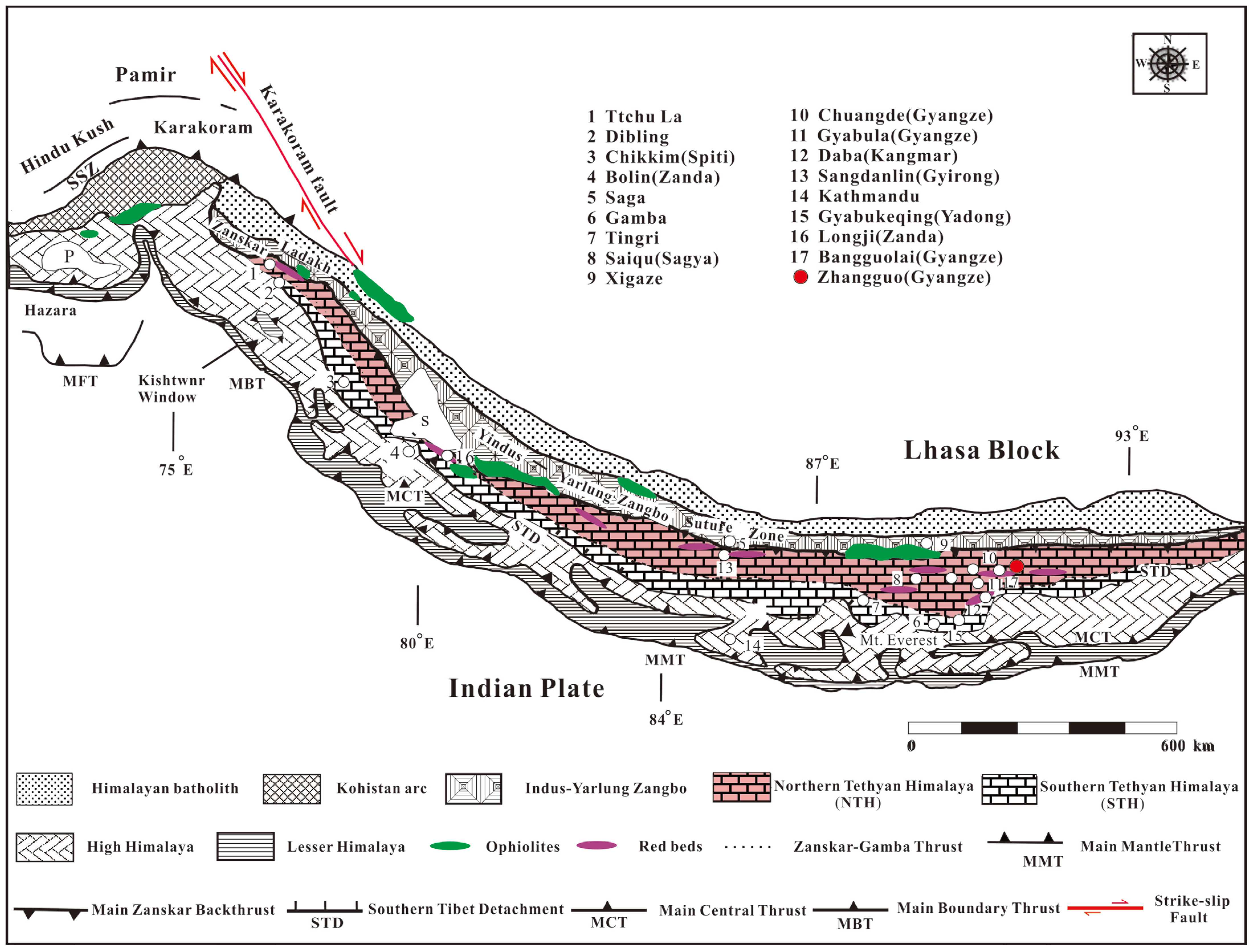

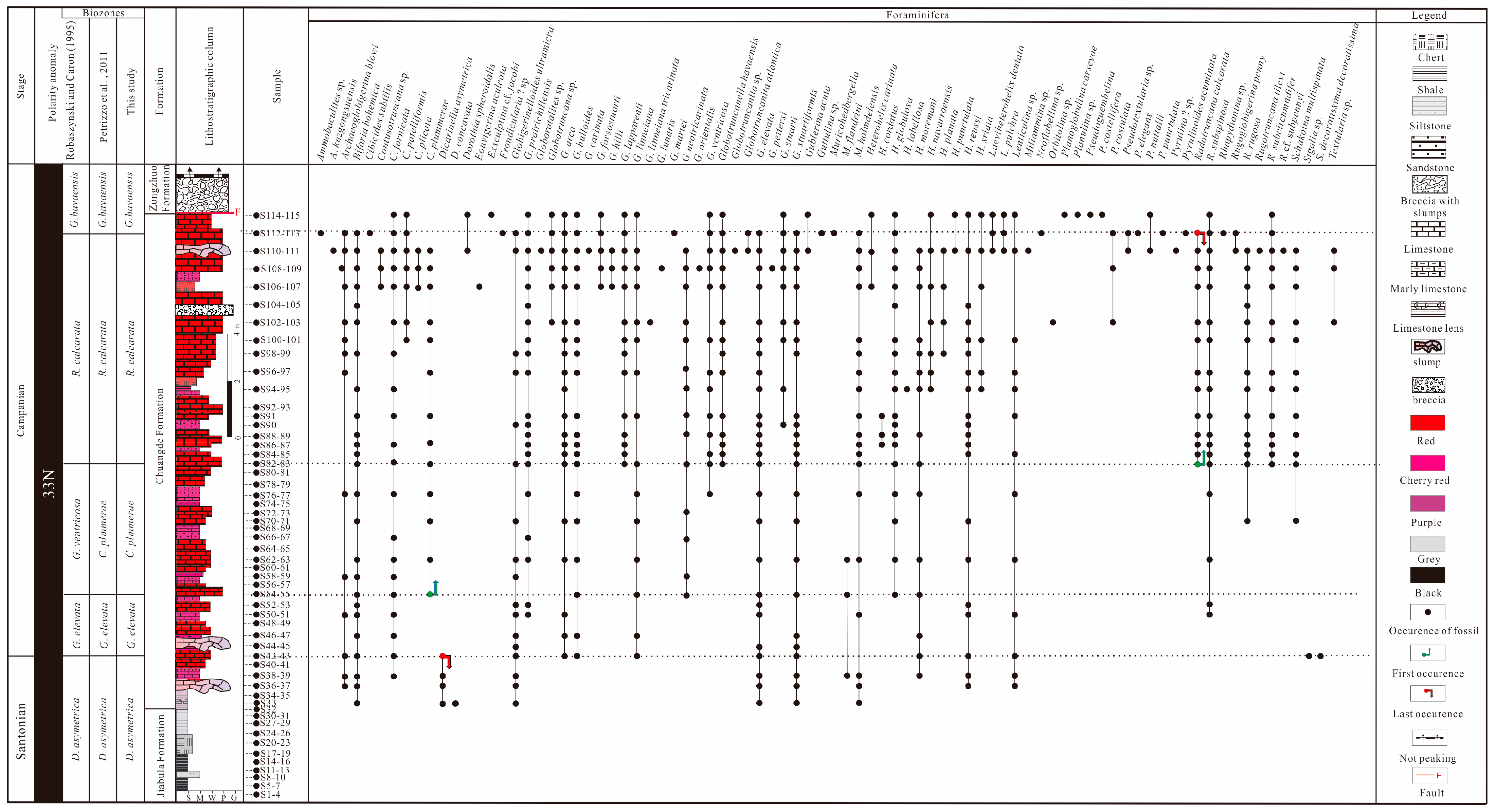
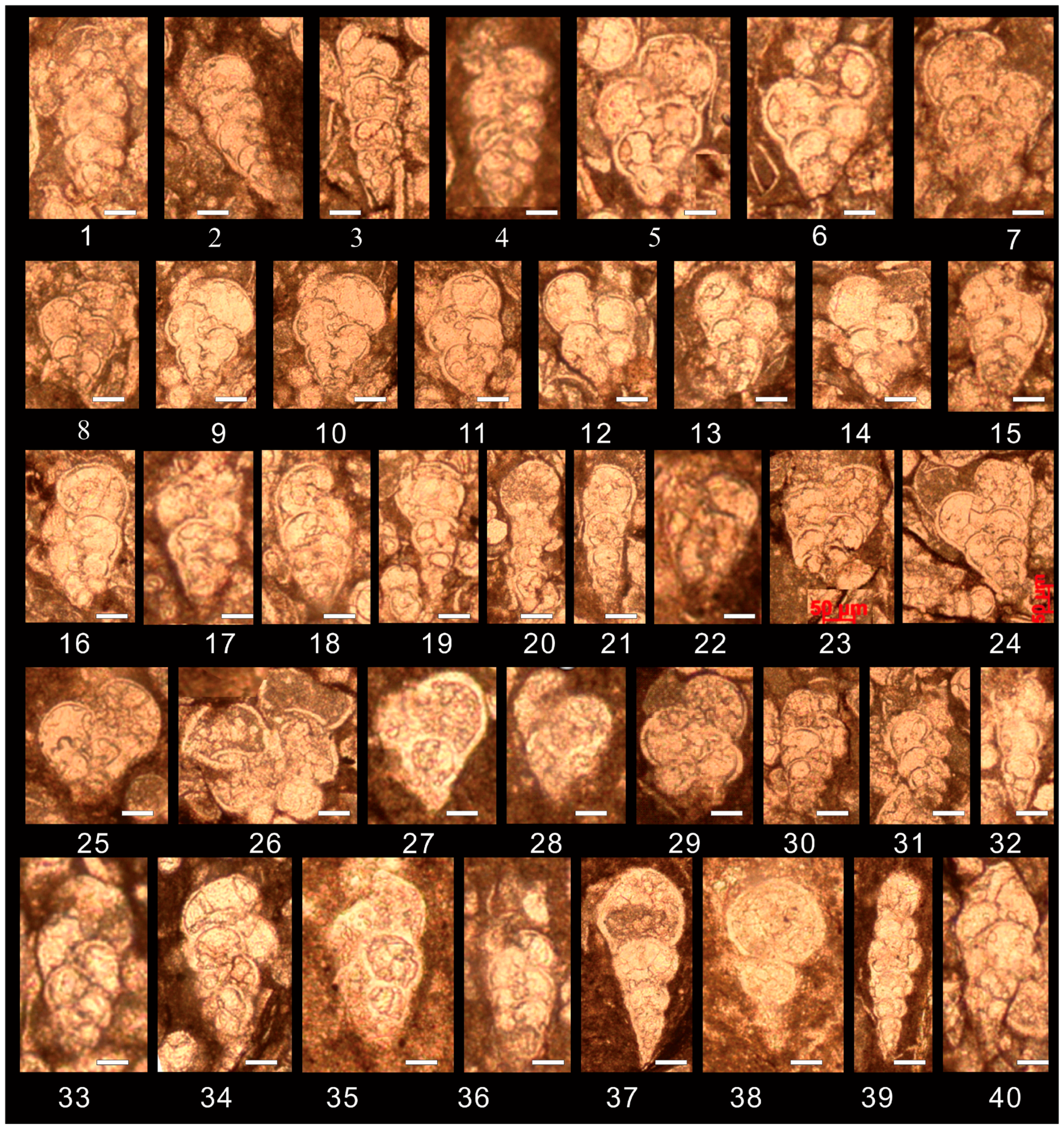
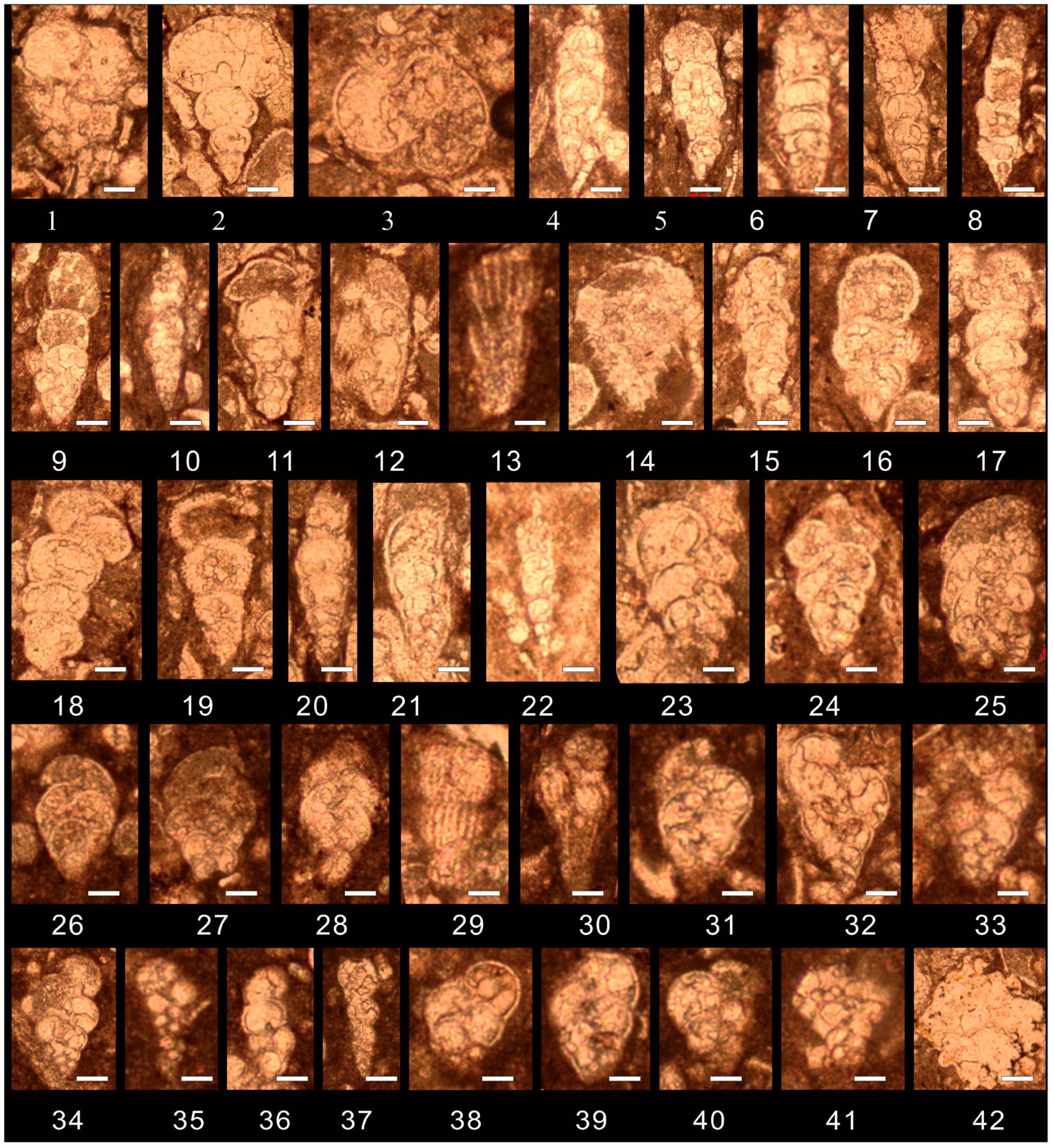
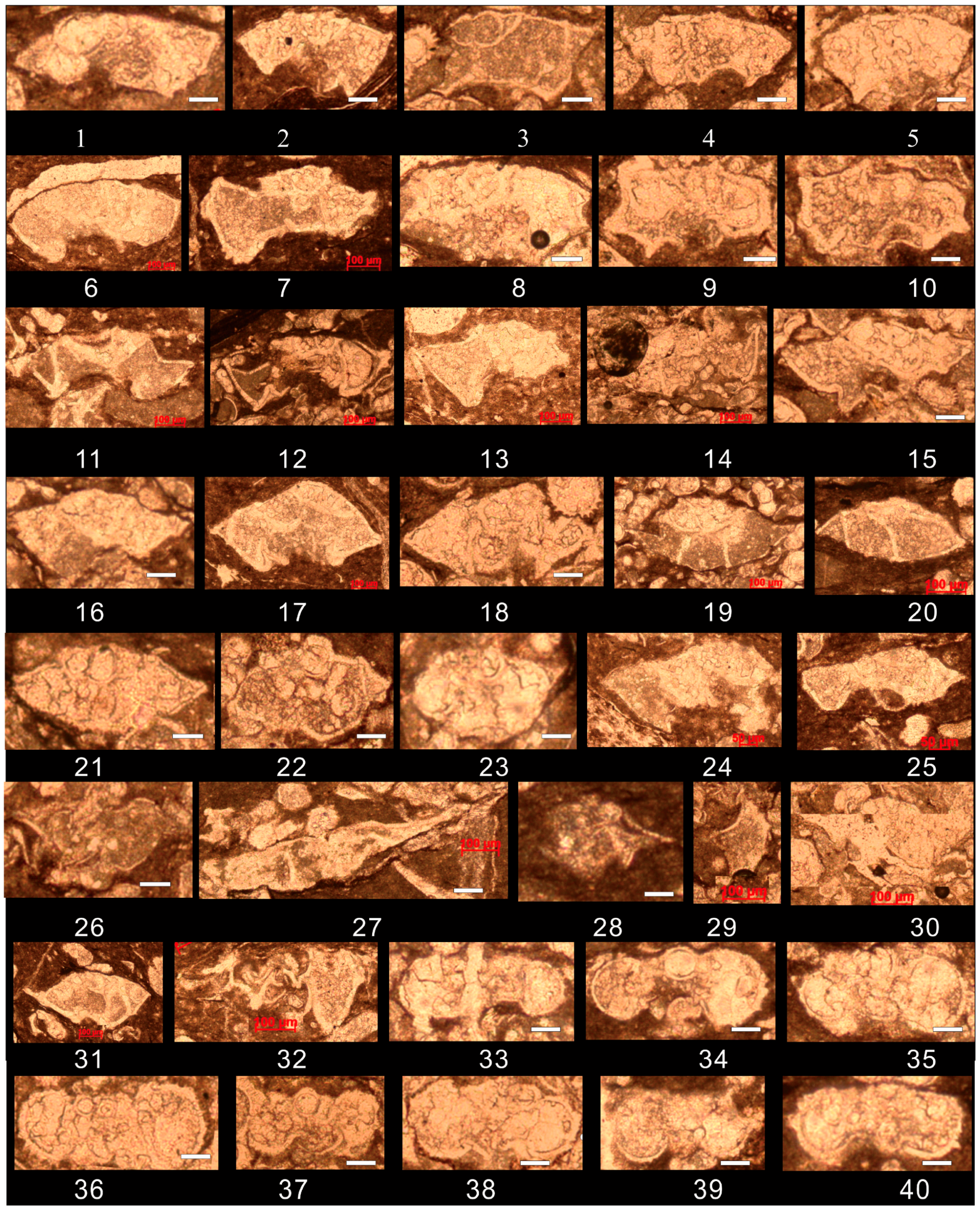
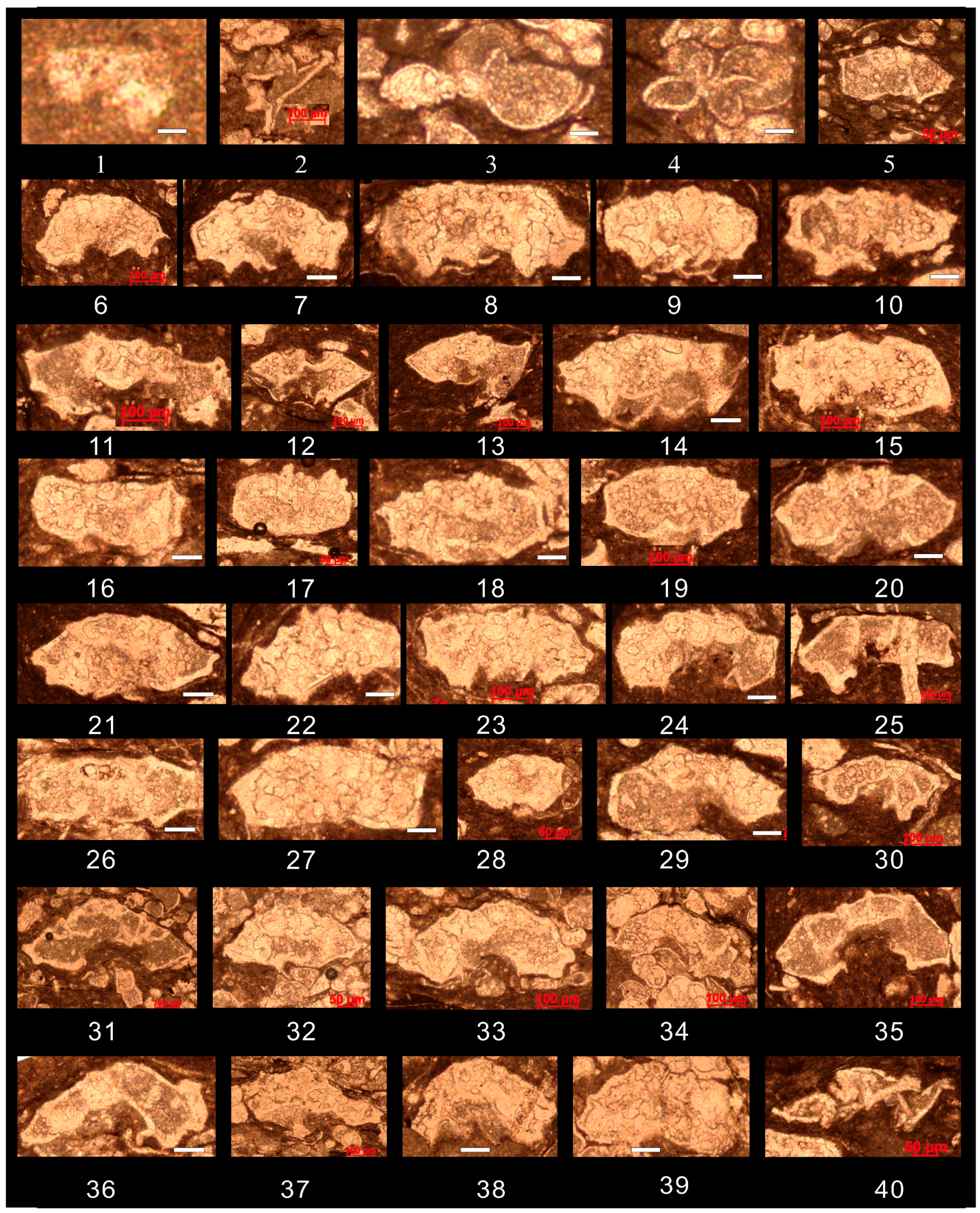
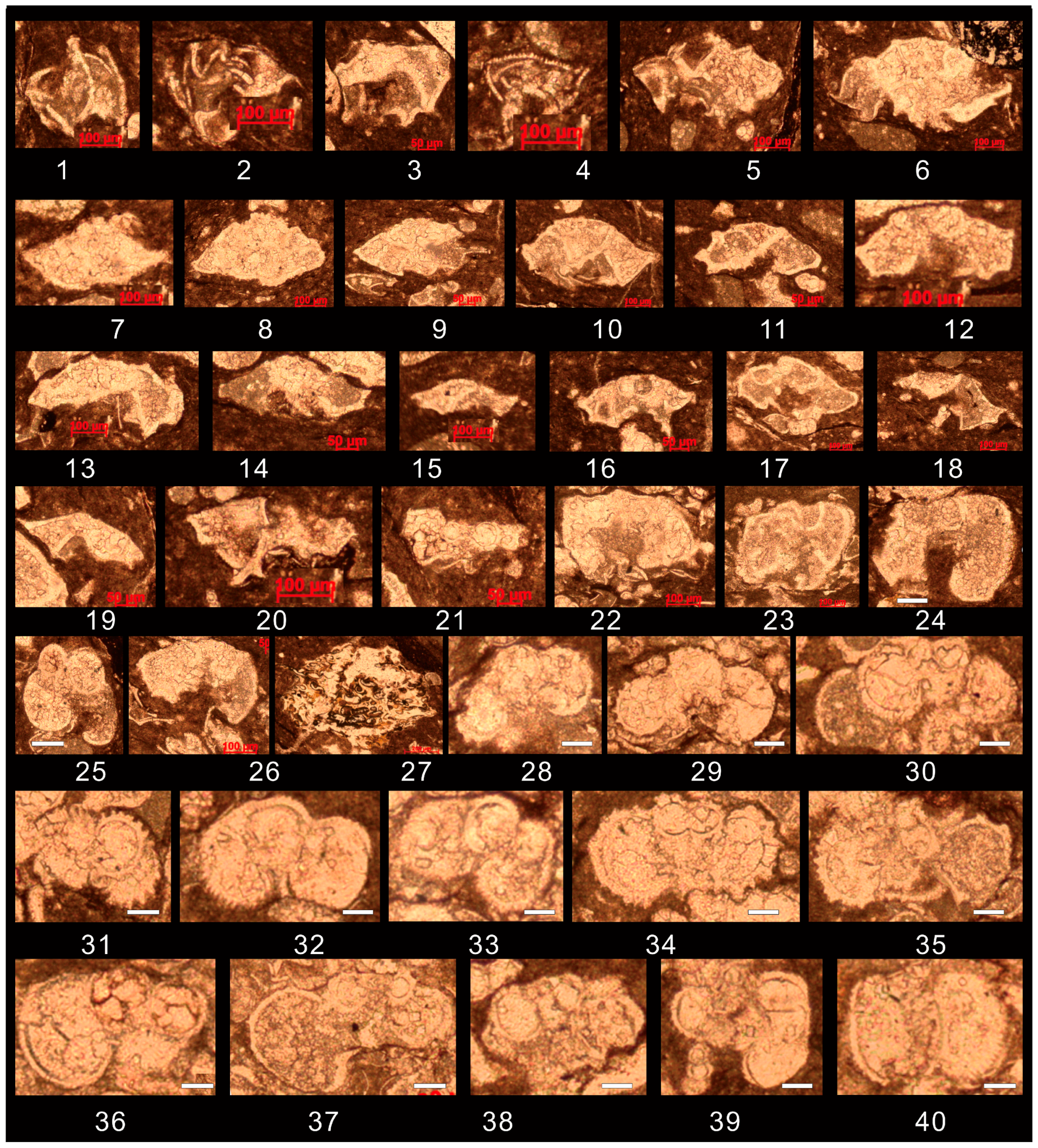
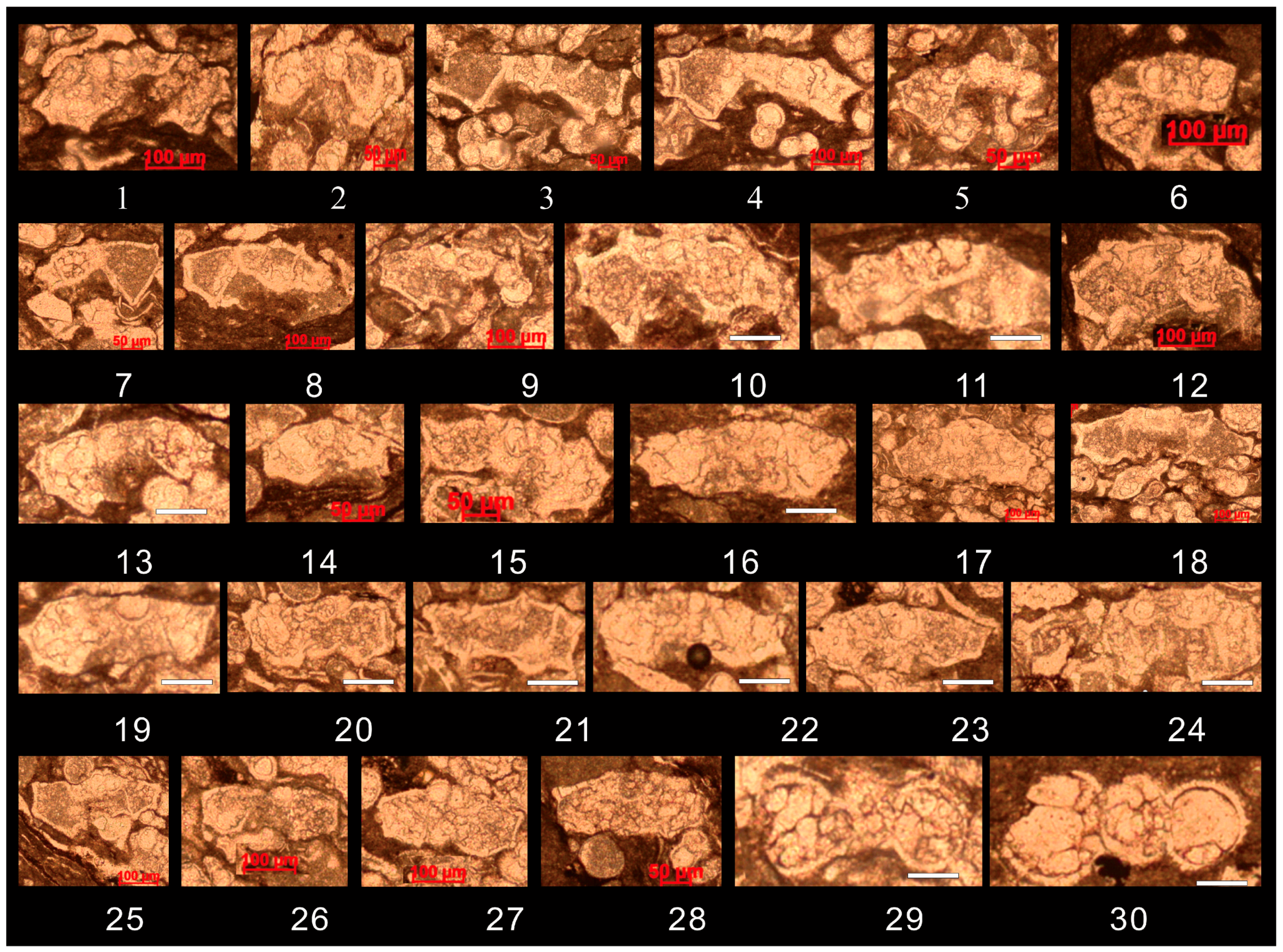
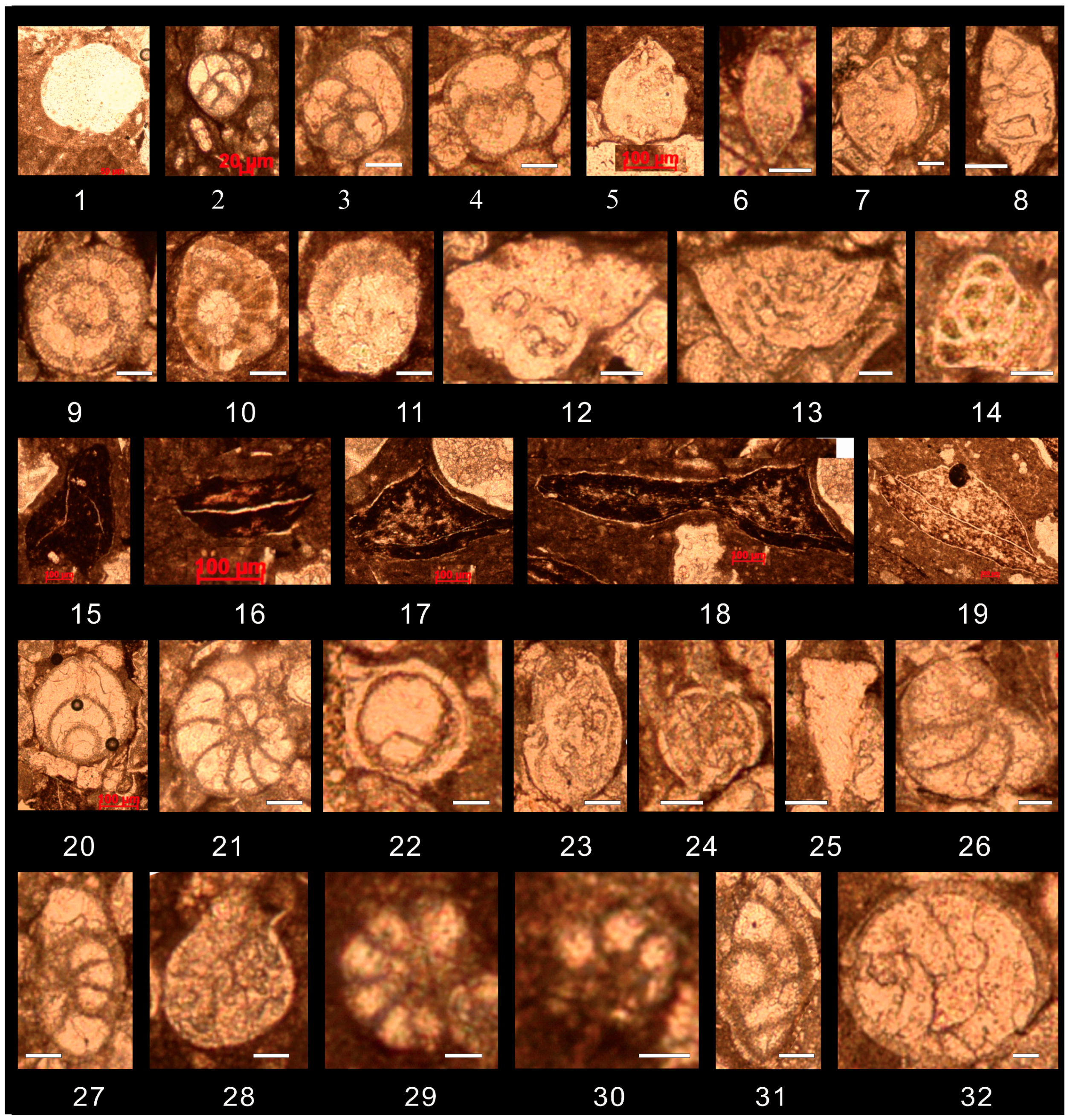
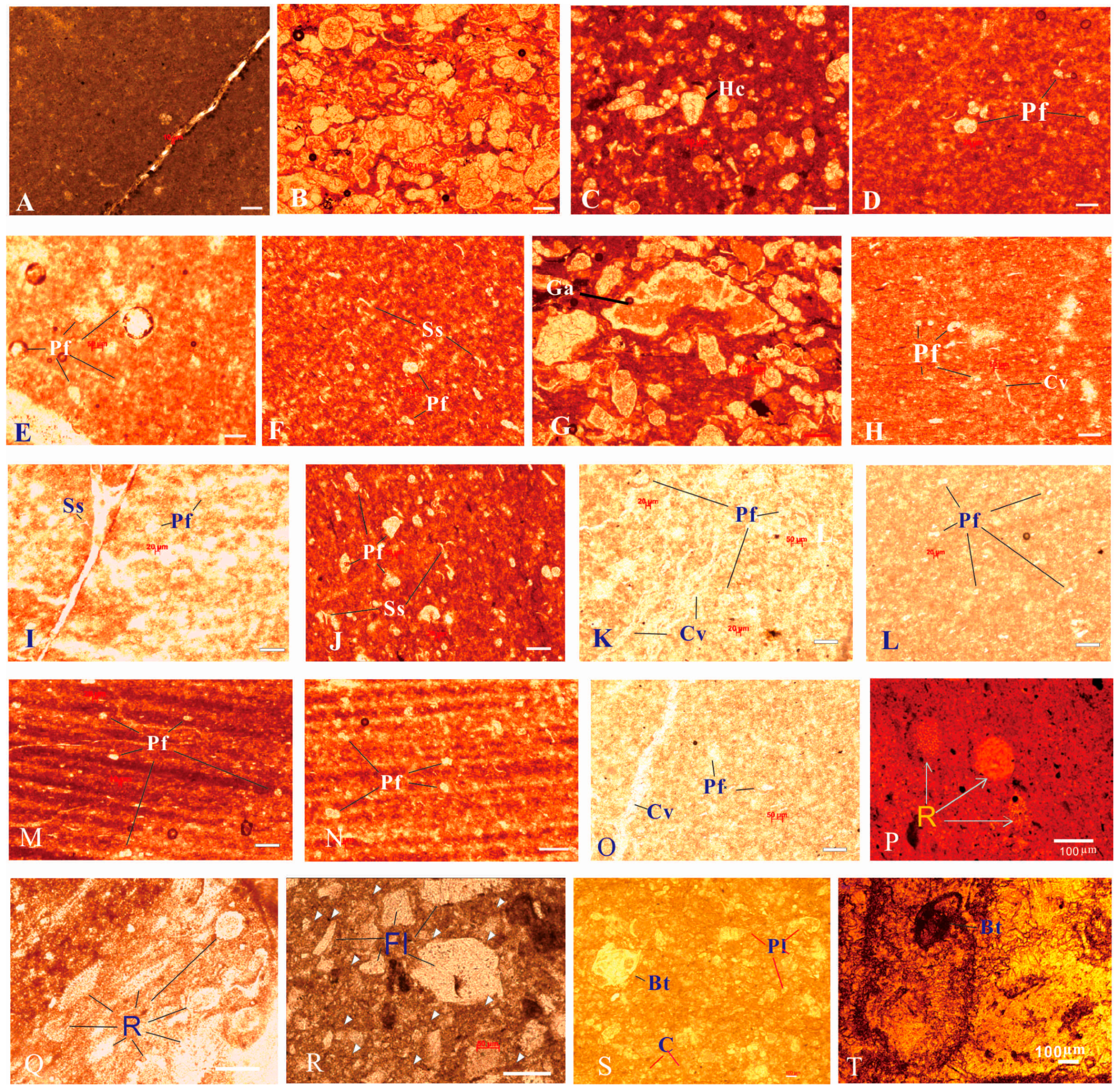
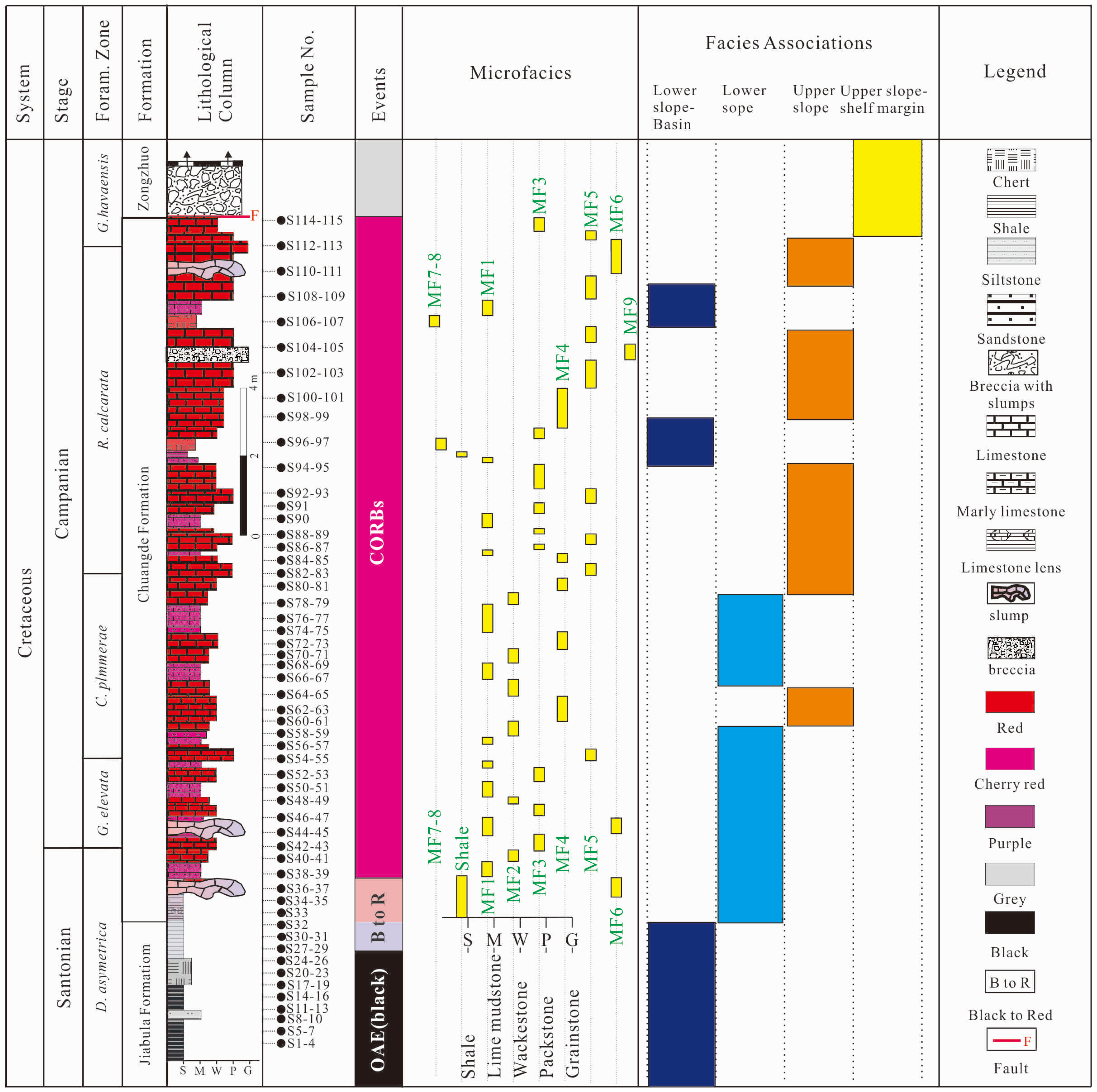
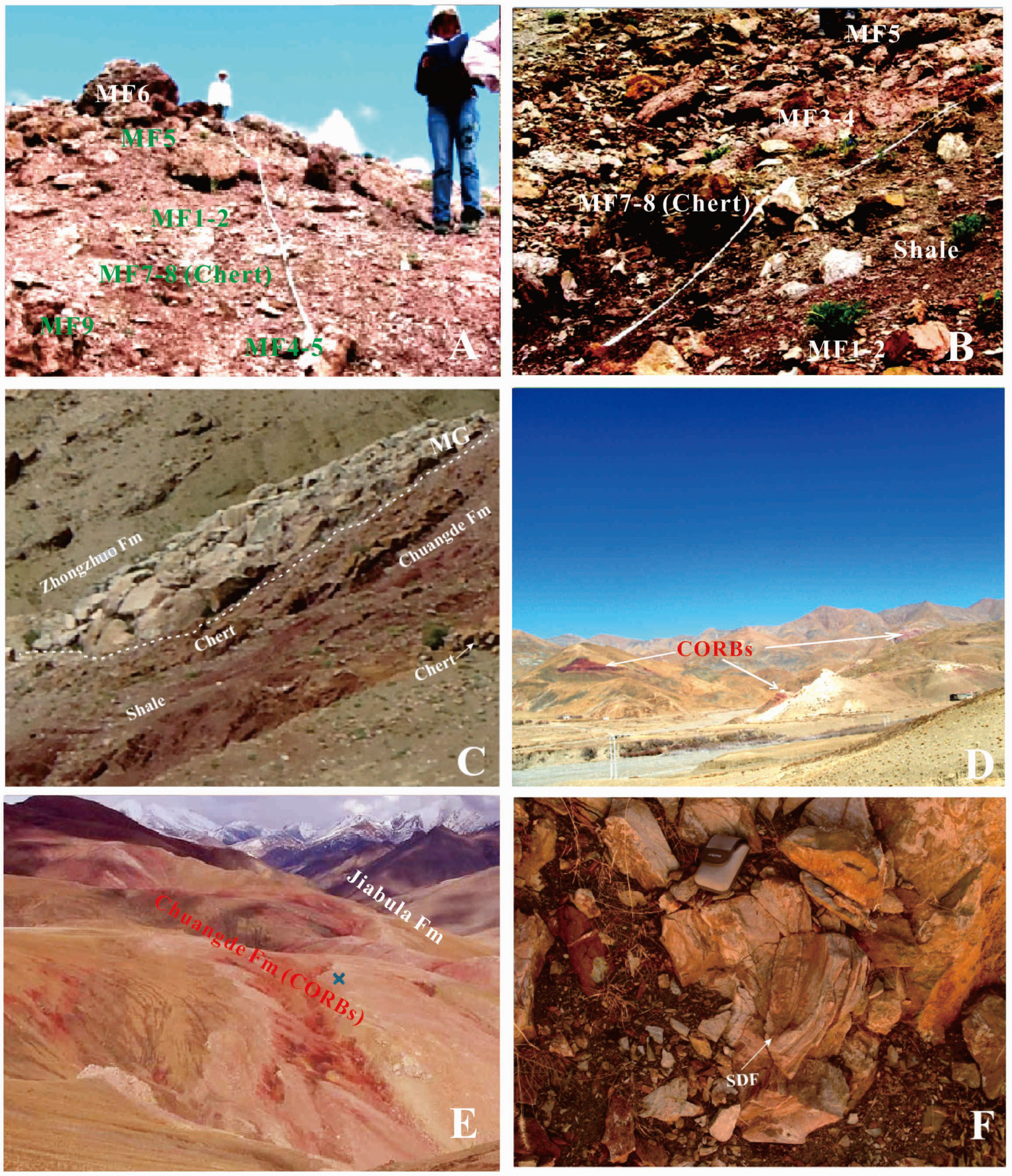
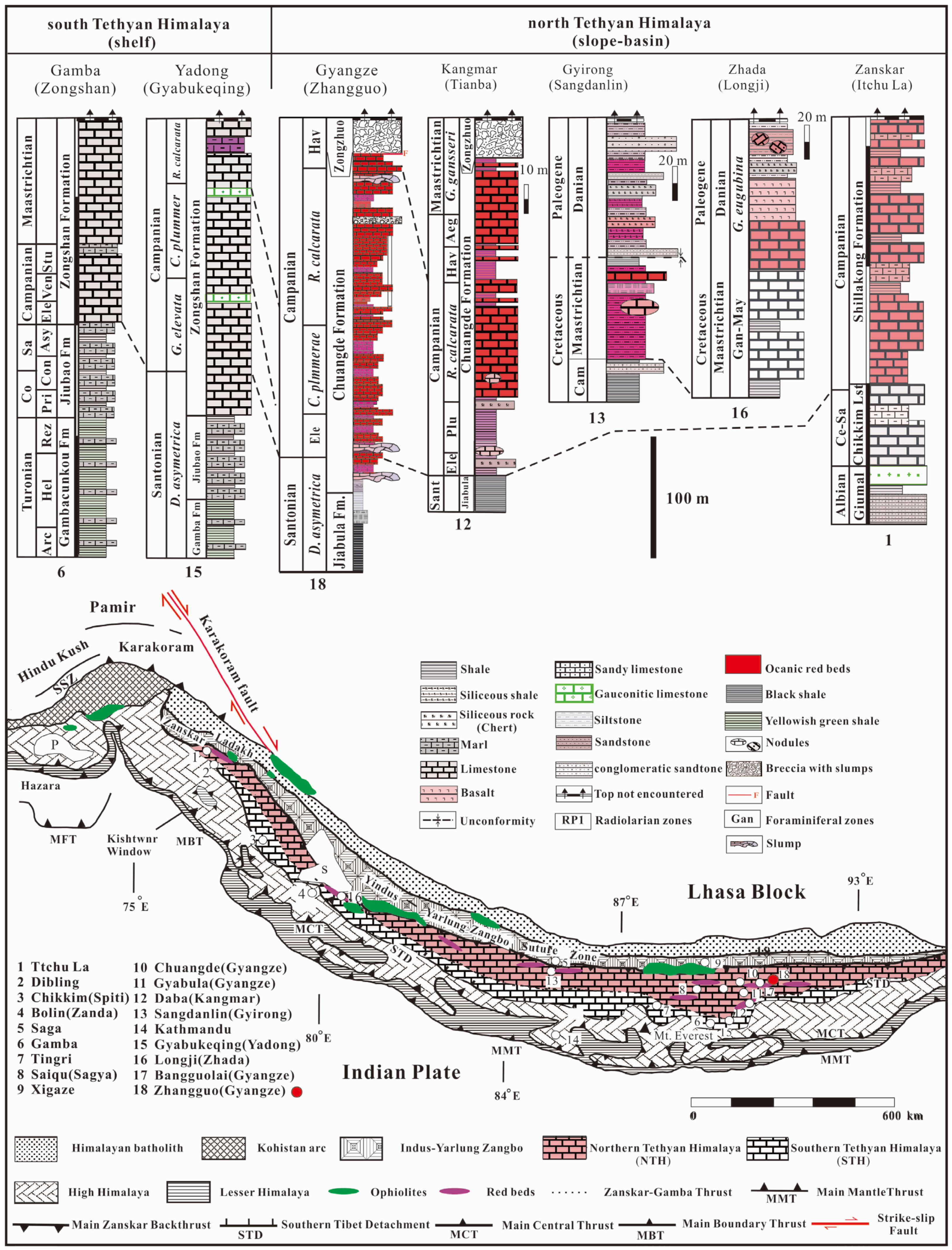

Disclaimer/Publisher’s Note: The statements, opinions and data contained in all publications are solely those of the individual author(s) and contributor(s) and not of MDPI and/or the editor(s). MDPI and/or the editor(s) disclaim responsibility for any injury to people or property resulting from any ideas, methods, instructions or products referred to in the content. |
© 2025 by the authors. Licensee MDPI, Basel, Switzerland. This article is an open access article distributed under the terms and conditions of the Creative Commons Attribution (CC BY) license (https://creativecommons.org/licenses/by/4.0/).
Share and Cite
Li, Y.; Li, G.; Ding, J.; Xie, D.; Wang, T.; Baoke, Z.; Jia, M.; Wang, C. Biostratigraphy and Microfacies of Upper Cretaceous Oceanic Red Beds in the Northern Tethyan Himalaya: A Case Study from the Zhangguo Section, Gyangze, Southern Tibet, China. Appl. Sci. 2025, 15, 7136. https://doi.org/10.3390/app15137136
Li Y, Li G, Ding J, Xie D, Wang T, Baoke Z, Jia M, Wang C. Biostratigraphy and Microfacies of Upper Cretaceous Oceanic Red Beds in the Northern Tethyan Himalaya: A Case Study from the Zhangguo Section, Gyangze, Southern Tibet, China. Applied Sciences. 2025; 15(13):7136. https://doi.org/10.3390/app15137136
Chicago/Turabian StyleLi, Yuewei, Guobiao Li, Jie Ding, Dan Xie, Tianyang Wang, Zhantu Baoke, Mengmeng Jia, and Chengshan Wang. 2025. "Biostratigraphy and Microfacies of Upper Cretaceous Oceanic Red Beds in the Northern Tethyan Himalaya: A Case Study from the Zhangguo Section, Gyangze, Southern Tibet, China" Applied Sciences 15, no. 13: 7136. https://doi.org/10.3390/app15137136
APA StyleLi, Y., Li, G., Ding, J., Xie, D., Wang, T., Baoke, Z., Jia, M., & Wang, C. (2025). Biostratigraphy and Microfacies of Upper Cretaceous Oceanic Red Beds in the Northern Tethyan Himalaya: A Case Study from the Zhangguo Section, Gyangze, Southern Tibet, China. Applied Sciences, 15(13), 7136. https://doi.org/10.3390/app15137136






